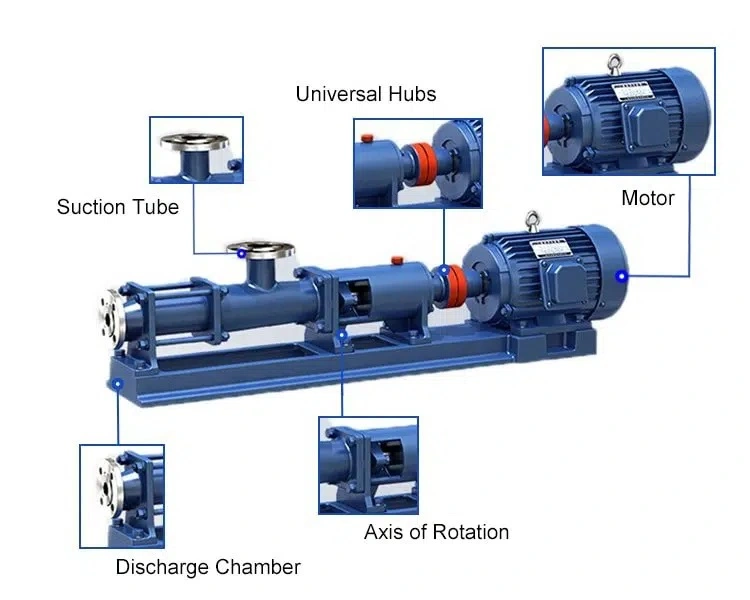A screw pump is a positive displacement (PD) pump that uses one or more screws to move fluid solids or liquids along the screw axis. In its simplest form, a single screw rotates in a cylindrical cavity, moving the material along the screw's spindle.
This ancient design is still used in many low-tech applications, such as irrigation systems and farm machinery used to transport grain and other solids.
The evolution of the screw pump has led to a variety of multi-axis technologies in which carefully crafted screws rotate in opposite directions or remain stationary in a cavity. The cavity can be profiled, creating cavities in which the conveyed material is "locked-in".
In offshore and marine installations, a three-spindle screw pump is widely used to pump viscous fluid under high pressure. Three screws propel the pumped liquid in a closed chamber. As the screws rotate in opposite directions, the pumped liquid moves along the spindles of the screw.
Three-spindle screw pumps are used to transport viscous liquids with lubricating properties. They are suitable for a variety of applications such as fuel injection, oil burner, supercharging, hydraulic, fuel, lubrication, circulation, delivery, and so on.
Positive displacement pumps have several advantages over centrifugal pumps. The pumped fluid moves axially without turbulence, preventing foaming that would otherwise occur with viscous liquids. You can also pump higher viscosity liquids without losing flow rate. Changes in the pressure difference also have hardly any effect on PD pumps compared to centrifugal pumps.
How Do Screw Pumps Work?
Screw pumps operate using two counter-rotating screw rotors which are engineered so that they rotate "towards each other". This traps the gas in the space between the "screws" of their rotors. As the screws rotate, this trapped volume decreases which not only compresses the gas but move it towards the exhaust.
In the first case, mechanical bearings support the rotors at both ends. The cantilever design solution supports the rotors at the high-pressure end and the rotors can be cooled internally. A motor drives the two rotors via a gear.
Gear and the bearings are lubricated but separated from the pumping mechanism ('vacuum generator') via shaft seals or labyrinth seals, thus the compression is oil-free. The rotors have no mechanical contact between each other and the pump housing, resulting in zero mechanical wear.
To keep the installed electrical power low, modern pumps are driven by an electronic frequency converter and rotate slower at pressure ranges near atmospheric pressure. Some versions use so-called blow-off valves instead to keep the rotating speed constant also at high pressures. Cooling is normally done by water.
Composition of the Screw Pump

Types Of Screw Pumps
There different types of screw pumps are available in the market in different designs. They are briefly discussed below.
1. One-Screw Pump
These pumps are named PC pumps otherwise progressive cavity pumps and worm Pumps. Generally, these types of pumps are not considered within the family of the screw pump. Because the rotor in these pumps is not like a usual screw but somewhat a twisted round shaft.
A progressive cavity pump includes one shaft with somewhat twisted within the form of a screw, & is enclosed within a pumping hall that is generally rubber lined.
2. Two Screw Pump
These pumps are also named the double screw pump, and it is the most general type used high power applications like weighty oil tube transfer. The screws in the pumps are driven from the motor, & timing gears are generally included to turn the next screw.
3. Three Screw Pump
These pumps are also named triple screw pumps, and these are usually used in small applications like lubrication systems. The screws in the pump are determined from the motor to rotate the remaining two screws which are around it without using timing gears.
4. Four Screw Pump
These pumps are basically two screw pumps, however with two screws for each rotor in opposite directions. These pumps absorb the liquid within the suction port, then divide evenly & are routed to both pumps’ ends.
The two liquids flow with the help of the pump towards the center & connect jointly again before leaving the release port. Similar to the double screw pump, this pump includes a timing mechanism to make the second rotor run. These pumps are frequently used within multi-phase applications & oil transport pipelines.
5. Five-Screw Pump
These pumps are mostly similar to a triple screw pump; however, with five screws, not three screws. Similar to the 3-screw pump, this pump includes one diving rotor that drives all the remaining screws. This type of pump is frequently used in many applications like tube oil otherwise hydraulic.
Advantages Of Screw Pumps
Screw pumps contain multiple screws that engage with one another as rotated to form a sealed cavity within the pump casing. As the screw drives turn, the fluid shifts steadily and constantly through the pump. It creates a volumetrically consistent flow rate that is unaffected by pumping pressure or viscosity that might slow down a centrifugal pump.
Some screw pump advantages include:
- Versatility with different flow rates, pressures, liquid types and viscosities
- Constant flow rates
- High volumetric efficiency
- Controllable output
- Low internal velocities
- High tolerance for entrained gases or air
- Smooth and quiet operation
- Very low pulsation
- Self-priming characteristics
- Reduced mechanical vibration
Disadvantages Of Screw Pumps
The disadvantages are as follows:
- They are bulky and heavy.
- They are sensitive to viscosity changes of the fluid.
- They have low volumetric and mechanical efficiencies.
- The manufacturing cost of the precision screws is high.
